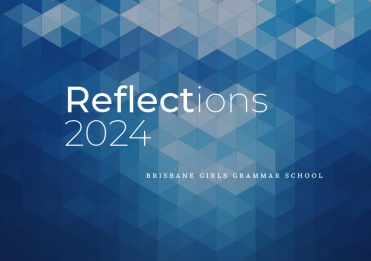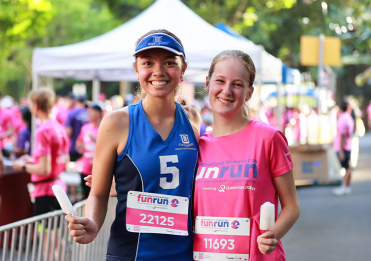Miss Meghan Parry, Head of Literature
Many of our senior students are embarking on the exciting and (for many of the adults in their life) terrifying journey of learning to drive a car. We all know, having been there ourselves, that inevitably there will be mistakes ranging from stalled cars to a few grazes along gutters. Ultimately though, making those mistakes—and learning how to avoid them—is how we all got our licences in the end.
Writing—and the dispositions required for it—is no different from learning to drive a car. The incremental learning, small mistakes, and a few scrapes here and there are not only part of the process but entirely necessary to getting ahead. But when it’s time for students to write, sometimes a fear of failure can be so paralysing that it prevents them from even putting the key in the ignition.
So what keeps girls stuck in park? Recently, I asked my Year 11 English class what they fear about writing and why, as one of my colleagues puts it, they can spend hours doing ‘furious sums’ but not ‘furious paragraphs’. The answers were varied, but a common thread was the idea that writing is deeply personal. That it’s exposing. That—unlike arriving at the ‘right’ answer to a maths problem—getting it ‘wrong’ seems so public. My Year 12 Literature students, who probably spend the most time writing with me, often lament that the blank page is the scariest thing they face because there’s so much room to muck it up.
As a Literature and English teacher, I understand this deeply innate fear. While it might seem vaguely heretical for someone who teaches writing for a living to admit this, it remains true. But there’s a simple, and luminous, solution to this fear of writing and it’s all in your disposition.
Approaching a piece of writing requires guts. Giving your writing over to others for feedback requires an exchange and a willingness to get it wrong. Some writers talk about the ‘really bad draft’ that lets them get started and others lament at the state of their digital desktop cluttered with half drafts. In her latest collection of essays Charlotte Wood tells us that, ‘It’s only in trudging out into that unknown space and starting work, often in the wrong place, wandering down many false tracks, getting lost and finding my way again too many times, that I’ll slowly find out’. What a lovely metaphor for the craft of writing—entering into the unknown, taking the wrong turn, doubling back, and finding your way home. Perhaps Robert Frost was right: sometimes taking the ‘road less travelled’ can make all the difference.
Still, there remains a misconception that writers are born and not made—and that the ability to write is a divine gift bestowed upon the few. This is simply untrue. Good writers, like good drivers, learn from practice and through making adjustments when things go off-piste.
There’s an idiom about eating an elephant that many of us will be familiar with. The idea is that the mission can only be accomplished if you take one bite at a time. In the same way, an incremental approach to writing can help us to muck things up in small ways so we become better writers. Charlotte Wood advocates for the necessity of making mistakes, showing them to others, and that the “painstaking work at the level of the sentence, the word” is the true process of writing.
In the English and Literature classrooms we provide lots of opportunity for girls to muck it up. From Year 7 through to Year 12, students cycle through a series of genres—analysing, creating, writing and re-writing, drafting and re-drafting—so that by the time it comes to an external exam at the end of Year 12, they know the road and the conditions, and they feel ready to drive unassisted. This culture of practice and learning from mistakes, means that in the end, students can remove themselves from the ‘work’ and fall back on the learning that they have cultivated over time.
Many successful writers embrace the idea of ‘failing forward’ to find the gold that sits within their writing, and I would argue, their ideas in their wider life. However, opening and embracing conversations about something that you’ve written does induce a psychological and evolutionary alert because we imagine that feedback puts us outside the ‘herd’. Having a disposition that embraces failure as a learning opportunity is certainly how we’ve achieved evolutionary success and that same evolutionary process will occur in writing, if we actively cultivate and embrace it.
In our classrooms we’re making more space (physically and online) for practice writing, peer editing, and frankly just getting it wrong. Embracing new learning routines from Harvard Project Zero like ‘My favourite no’ and ‘I used to think, now I think’ help our students to value their mistakes and provide a platform for them to find a new path to success. We retain student drafts and pin their first ideas up on classroom boards (or Collab docs on Minerva) to celebrate the ways they’ve changed their minds or explored a new idea. But we can always do more as a community to ensure that our young learners embrace this disposition of a mistake and see it as a step forward, rather an abject failure.
Our students and our teachers are lucky to have each other as partners in a learning journey. What we all must remember as the more sagacious members of our school community, is that our young learners cannot strive for perfection at every moment and that making a mistake will not hurt them. In fact, as learners who have made hundreds of mistakes and who will continue to make them, we need to remember to actively celebrate and embrace these so that our young minds can see that making a mistake—or mucking it up—will only let us learn something new.
So perhaps it is time to embrace ‘furious paragraphs’ and treat them like driving lessons. Failing forward and letting our students do it with gusto will not only help them in their immediate high school lives, but it will set them up with dispositions that allow them to flourish as life-long learners and risk-takers.
Now is the time for failure. Let it be luminous, let it be relished, let it be learned from.
References:
- Wood, C. (2021). The Luminous Solution: Creativity, Resilience and the Inner Life, Allen & Unwin, Crows Nest, NSW.
Clark, L. (2016). Beautiful Failures, Penguin Random House, North Sydney, NSW. - Ritchhart, R., Church, M., & Morrison, K. (2011). Making Thinking Visible: How to Promote Engagement, Understanding, and Independence for All Learners, Jossey-Bass, A Wiley Imprint, San Francisco, CA
- Plunkett, F (2021, October 1) Charlotte Wood’s vision reveals the dark and light of unshackled creativity. The Sydney Morning Herald. Retrieved from: https://www.smh.com.au/culture/books/charlotte-wood-s-vision-reveals-the-dark-and-light-of-unshackled-creativity-20210927-p58v6g.html







